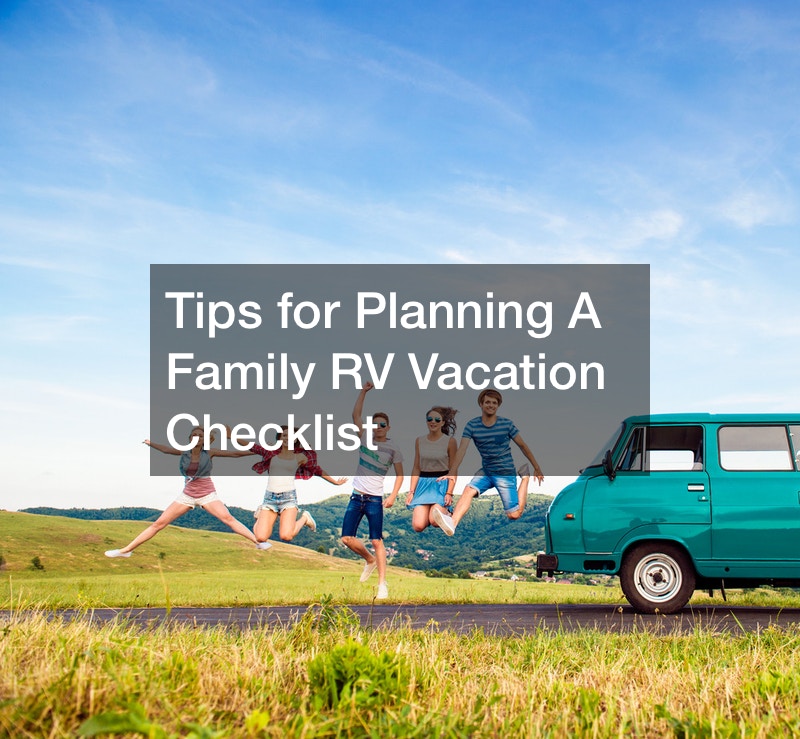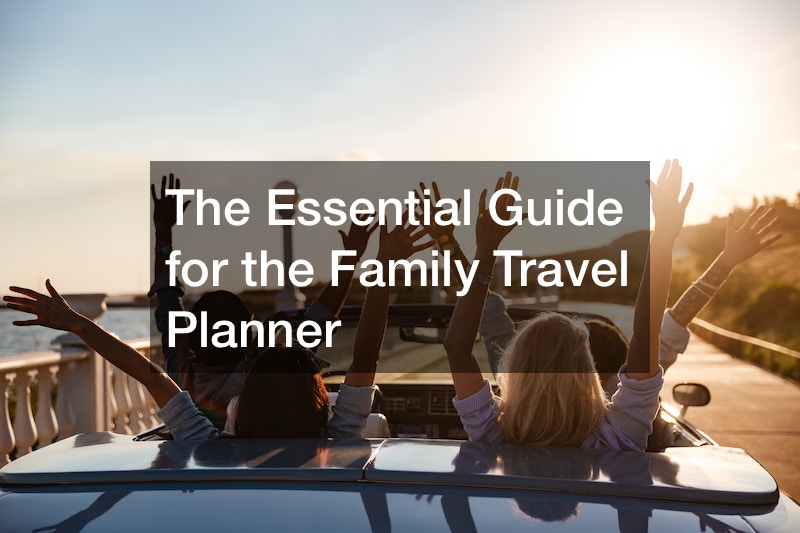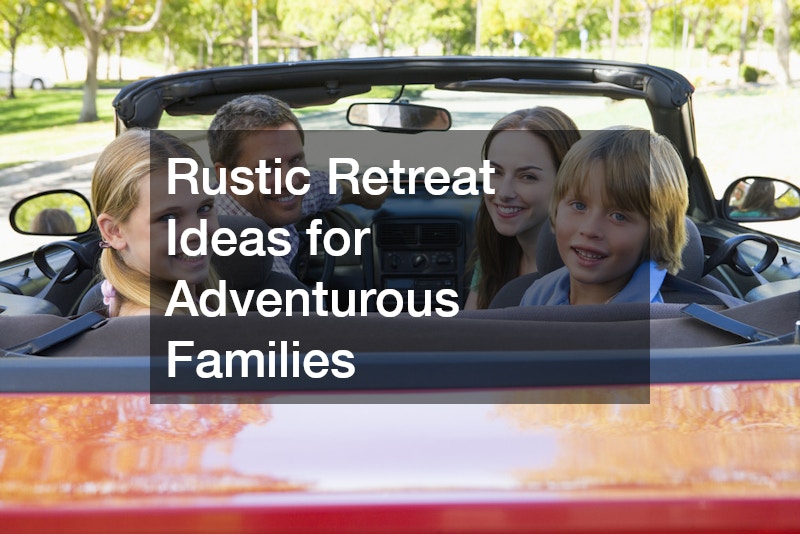Tips for Planning A Family RV Vacation Checklist


If you are planning to go on a family RV vacation, there are some things you should know and prepare. Before you book the trip, you want to make sure that you understand everything that needs to be done before and on the trip. With the help of this planning a family RV vacation checklist, your trip will be more enjoyable and safe.
Choose the Perfect RV

Before you head out to a nearby RV shop, make sure to think about these important factors. There are many options when it comes to RVs and your lifestyle will help determine what type of RV is best for you and your family. The vehicle you choose will impact everything from the length of time you will be able to stay on the road, where you can go, and how much fun it will be for everyone involved.
Before selecting an RV, there are two important things to keep in mind:
- Think about what you need versus what you want. It’s easy to get distracted by all of the bells and whistles that come with many types of RVs, but it’s better to focus on finding an affordable vehicle that has plenty of space for everyone in your group and meets your needs based on where you plan to go and how long you want to stay out on the road.
- Contact automobile insurance companies for quotes on coverage
- Be realistic about your driving ability. If this is your first time driving an RV, don’t opt for a huge Class A motorhome (the largest type) or a towable trailer that requires a full-sized pickup truck with dual tires and a heavy-duty tow package to haul it safely down the road. Start small – buy or rent one that’s easier to maneuver if this is your first time behind the wheel of one of these vehicles – and work up from there as your skill level improves!
Types of RVs
Class B Van Camper (Smallest, usually 1-2 people)
As mentioned above, the class B RV is commonly a van that has been converted into an RV. This type of camper has many options:
- A van with a pop-up roof. The pop-up roof expands when you are ready to use the bed, and lowers when you’re driving or storing it. You may have to lift your luggage into the RV or possibly through a side door depending on its dimensions.
- A high roof van without a pop-up roof but with plenty of headroom throughout. The top of this van will be level with the tops of vehicles around it on most highways so there can be some difficulty merging into traffic. These vans may require a ladder to climb in and out although many now include steps built into the body for easy access.
- A low-profile campervan that looks nearly identical to a standard delivery van from the outside but has ample room inside when parked. These vans can also be hard to merge into traffic due to their low height but are often easier than high roof vans as they sit lower off the ground and typically have running boards for easy entry/exit.
Class C Motorhome (Medium size, around 10 people)
A Class C Motorhome is a great choice for camping. It’s one of the most popular campers with families. Sleeping up to 10 people, it’s more affordable than a Class A motorhome and can be as large as a Class A, but more compact.
These are built on the chassis of a commercial van and usually have a raised roof, with a bunk over the cab. The driver and passenger sit in front while the kitchen and sofa area take over the back portion of the motorhome.
Some of these RVs can be used as standard motorhomes or even primary residences! They are perfect for traveling around in style without sacrificing any comfort.
Towable Trailers (Towed behind an SUV or truck; medium size)
Towable trailers are towed behind a vehicle. One of the advantages of this type of RV is that it tends to be easier to set up and take down than other types. If you have an SUV or truck, this could be a good option for you. Towable trailers come in a variety of shapes and sizes, but one of their main advantages is flexibility. There are generally 1-2 bedrooms, but some can sleep up to three families comfortably! They may also have slide-outs (a section that can extend outwards from the side), which increases usable space inside your camper. You will want to make sure you have room for storage on your vehicle’s hitch after you add the trailer.
Fifth Wheel Trailer (Medium size; towed with a trailer hitch in a truck bed)
If you’re a fan of pickup trucks and don’t want to leave your truck at home, a fifth wheel could be the perfect choice for your family. Fifth wheels are a type of travel trailer that attaches to the bed of a pickup truck with a kingpin hitch. They offer more amenities than most other RVs, plus have greater storage capacity, making them ideal for long-term road trips.
Prep Your Vehicle for the Journey
Before you leave, be sure to have your vehicle serviced by a mechanic to ensure that everything is working properly – from auto body work and auto tinting to suspension checks. There is nothing worse than being stranded on the road with a broken-down RV while traveling with children. You’ll also want to make certain that you have all of the proper equipment, including a portable toilet, extra gas cans, and first aid kits.
You should also prepare yourself for what may come your way. Review the list below of items to pack for your vacation:
- Sunscreen and insect spray
- Extra Gas Cans
- First Aid Kits (for both humans and pets)
- Portable Toilet for use when campgrounds are full or closed down at night time
In addition to packing all these things prior to departure, you should also make sure you have a good supply of food and water before leaving home so that there will be no need for running back into town again mid-trip just because someone forgot something important like milk or bread!
Pack the Essentials

- Clothing – You’ll want to pack clothes for all types of weather, especially if you’re exploring the great outdoors. Make sure you have enough socks and underwear for each person in your party. Don’t forget rain gear and swimsuits!
- Kitchen – The kitchen is the most important room in a motorhome or campervan, so don’t skimp on supplies. Pack an assortment of plates and utensils, cooking tools such as pots and pans, cutting boards, a can opener, and more. If you’re camping off-the-grid with no electrical hookup for your refrigerator/freezer unit, make sure to bring plenty of ice!
- Food – If you’re planning on cooking on vacation (and why wouldn’t you?), make sure to bring seasonings, condiments, salad dressing, and other items like oil or butter to use in food preparation. Bring plenty of water bottles with you–you’ll need lots of fluids while traveling!
- Personal Items – Some people love having their creature comforts on hand when they’re away from home–pillows from their bed at home are one example! Have everyone in your family pack their favorite pajamas or stuffed animals if that’s what makes them feel at ease during travel.
- Medication – Even if it feels safe to overdo it on the travel days by taking an anti-motion sickness pill beforehand, it’s best not to skip medicine altogether! Pack any medication that anyone in your family takes regularly so that nothing gets left behind at home. This includes over-the-counter meds like aspirin as well as prescriptions from doctors’ visits.
Make Proper Pet Accommodations

If you bring your pets along on your RV adventure, remember to consider whether their personal needs and comfort can be accommodated. You’ll also want to make sure that you’re abiding by campground regulations regarding pets, including dog training and the type of dog bedding or kennel set-up that’s allowed. If you plan on bringing your dog for walks outside of the campground, look up information on parks and trails in the area so that you know where it’s safe to take them.
Don’t forget to restock your pet’s food supply before departing as well as bring a proper water bowl and toys. And while it’s important to bring identification tags with you in case they get lost, it could also be a smart idea to get your dog microchipped too – just in case they manage to shake off their collar while they’re out exploring.
Plan Out Scenic Stops
If you’re planning your RV vacation, make sure to plan for a few scenic stops. Pick out a few scenic spots along the way that you think everyone will enjoy and plan to stop at these places as you travel to your destination. This will create a more enjoyable experience for everyone. Fading murals and paint work are amazing places to stop and take those Instagram-worthy pictures.
Buy Tickets Ahead of Time

Be sure to purchase tickets for the attractions you want to see beforehand. Many of the most popular museums and axe throwing events sell out quickly and may not have available tickets by the time you arrive. If your family enjoys theme parks and broadway & musicals, buying tickets online is a great way to save a little money, and ensure that your crew spends more time enjoying the activities rather than waiting in line.
Make Sure Your RV Is Insured
It’s important to make sure your RV is insured because if it’s not, you could be held liable for personal injury or property damage caused by the RV during an accident. While it might seem like common sense to make sure your RV is insured before you go on a trip, most people forget this step and end up taking out unnecessary insurance when they could have saved money by getting a policy that covers both the vehicle and its contents.
The good news is that many companies offer both comprehensive coverage and personal effects protection in their policies. Comprehensive coverage provides protection for losses due to fire, theft or vandalism while personal effects coverage will protect any belongings inside the RV from theft. If you have any questions about which type of policy is best for your needs, contact your insurance provider before you depart.
Tips for Planning A Family RV Vacation Checklist
- Plan a budget
- Research your options online
- Choose your vehicle type (Class-A, Class B, or Class C) based on the size of your family and how much you want to travel with them.
- Get an RV that fits within your budget.
Planning a family RV vacation can easily be done with this checklist!
- Choose a location. If you’ve thought about it long and hard, now might be the time to settle on a preferred RV park or campground. Though this probably won’t be your home for the duration of your trip (unless you have relatives who happen to live nearby), choosing a site will help you when it comes time to book your hotels and restaurants.
- Make a checklist. Once you’ve chosen a location, come up with an idea of what you want to do at the place (e.g., visit museums, hike trails, shop, sightsee). Now add these activities to your planning a family rv vacation checklist. You’ll be glad later that you did!
- Logistics and documentation. If you don’t have much experience in traveling with others, this task will seem daunting at first—you may even find yourself resisting checking off each item on the list! Make sure the RV is covered by renters’ or homeowners’ policies as well as auto insurance if needed; check with local laws about what’s required by law before making any purchases!
- Determine where you will park it when not in use (driveway or storage).
- Budget and finance. A family’s finances can quickly become complicated if there are children involved (especially by someone’s ex-wife). You’re going to need some way of tracking expenses during the vacation period so that everyone knows where their money is going. Fortunately, there are plenty of free budgeting tools available online if your family isn’t into spreadsheets yet.
Hopefully, this post with the planning a family RV vacation checklist will help you feel more confident in your planning efforts and ready to start the family vacation of a lifetime. With these tips and resources, your RV dream trip is within reach!







